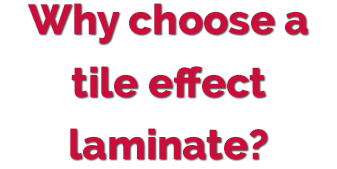I’ve been installing tile effect laminates for over 15 years now and to be frank, they started off very poor.
The manufacturing techniques left room to be desired. You had to spend serious money to get the quality, and even then it wasn’t that great.
The industry was young and was just finding it’s feet. Over time I’ve seen the complete evolution of laminate floors and to say the new ranges currently hitting the market are far better, is an understatement!!
I’ve seen the introduction of embossed registering. In laymen’s terms, a raised textured effect. Now you can really feel the laminate tiles and see the depth in the surface finish which has become indistinguishable from real tiles.
The leaders in the domestic field and now getting stronger in the commercial markets being Quick-Step. I harp on about Quick-Step products a lot, but there’s very good reason for that. I mean if you’ve been eating at the same take away or restaurant for years, there’s good reason why you keep going back, right?
Now whether we’re talking about a tile effect laminate or wood effect, the same benefits apply.
As a laminate is an overlay floor, which means it is installed on top of an underlay, the standard required sub-floor preparation is a lot less than it is for a conventional ceramic tile. The sub-floor simply needs to be flat, dry and dust free. Where as for ceramic tiles, there can be pretty extensive and expensive sub-floor preparation required. Have you seen the cost of 18 mm ply board lately?
If a property has two different types of sub-floor, for example, concrete and wood floor boards, this can be easily dealt with by the use of an underlay. With real tiles, changes in sub-floor types can pose an expensive problem on the grand scale of things.
In this day and age, people tend to want things done fast and with as little mess as possible. With a laminate floor, this can be achieved and often is. Installations, even by diy’ers taking a day or so depending on the room size of course. No need for waiting around while adhesives dry! Just click and done! I’ve found this aspect of a laminate floor to be very much a selling point for my clients.
Should a laminate floor require taking up, perhaps due to a damaged plank or if access is required underneath the floor, this can be achieved with ease. Whereas, removing a conventional tile floor
can get very messy and will often need replacing all together. A laminate can simply be re-fitted. That’s if it’s a decent laminate, like Quick-Step! Sorry, couldn’t resist mentioning the name.
Clients are often concerned about water damaging there new tile laminate. It’s fair to say that ceramic tiles are more hardy when it comes to water, however, like everything in this technological age, there is a solution.
I’ve been using moisture guard products for years with exceptional results. Moisture guard is almost like a silicone or wax type product which seals the locking system of the laminate tiles, greatly helping prevent water ingress.
We install it around key areas within a kitchen or bathroom floor such as around the sink, bath, external doors etc. Sometimes our clients ask us to install it in the full kitchen or wherever. Moisture guard products are extremely cheap and most don’t glue the tiles together, keeping them re-usable if removed! So to any doubters, don’t worry, there’s a solution for everything when it comes to flooring..

Good product and great post, Thanks for sharing…..
I think this is one of the most vital information for me.
And i am glad reading your article. But should
remark on feew general things, The web site style is perfect,
the articles is really excellent : D. Good job, cheers
Laminate with tile effect, it’s really good concept. Products are good. Nice info…